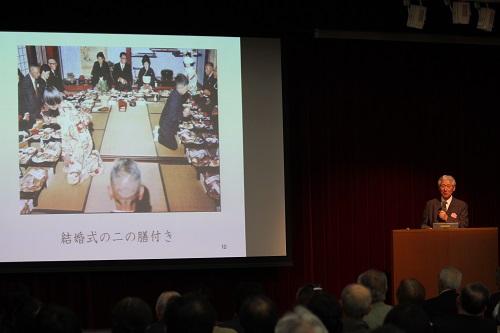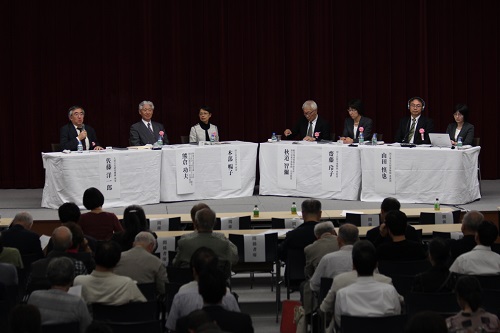No.011 - The 29th NIHU Symposium: Diversity of Japan’s Dietary Cultures – Thinking about Dietary Cultures on food production, processing and consumption
The 29th NIHU Symposium: Diversity of Japan’s Dietary Cultures – Thinking about Dietary Cultures on food production, processing and consumption
Customs on food based on the modern Japanese mentality of valuing nature were inscribed on the representative list of the intangible cultural heritage of humanity of the United Nations Educational, Scientific and Cultural Organization (UNESCO) under the title, “Washoku; Traditional Dietary Cultures of the Japanese,” in December 2013.
Food and its culture are closely linked to the history, climate, geographical conditions, courtesies and other so-called customs of each region. Diverse regionally rooted cuisines and customs exist in all parts of the world for that reason. However, opportunities to pass on food customs have diminished in Japan with the increasing Westernization of food in recent years. There are also concerns that food ingredients, cuisines and flavoring peculiar to each region will also become standardized with the greater movements of people and goods caused by the evolution of transportation systems and information transmission methods. The attraction of travel may be spoiled if the same ingredients are served all over Japan.
The National Institutes for the Humanities (NIHU) cosponsored the 29th NIHU Symposium titled “Diversity of Japan’s Dietary Cultures – Thinking about Dietary Cultures on food production, processing and consumption” with the Ajinomoto Foundation for Dietary Culture on Saturday, October 15, 2016. At this Symposium, lecturers answered questions about the diverse foodways found on the islands of Japan from their respective academic viewpoints and gave thought to how dining tables in Japan will look going forward.
Opening the Symposium, Isao Kumakura, the Chairman of the Washoku Association of Japan and a professor emeritus at the National Museum of Ethnology, delivered a keynote speech on the theme, “What is the Washoku Culture Inscribed on the UNESCO List of Intangible Cultural Heritage of Humanity?” In his keynote lecture, Kumakura explained the background to Japan’s dietary cultures’ inscription on the UNESCO list of intangible cultural heritage of humanity and the definition of Washoku. In a presentation that followed, Shinya Yamada, an associate professor at the National Museum of Japanese History, introduced food customs found in courtesies handed down in respective parts of Japan under the title, “Development of Courtesies and Washoku.” The third speaker, Reiko Saito, an associate professor at the National Museum of Ethnology, gave a presentation on food customs found in courtesies preserved by the Ainu under the title, “Food of the Ainu and Trade.” Next, Nobuko Kibe, a professor at the National Institute for Japanese Language and Linguistics, introduced food ingredients used in the cuisine of Okinawa and dishes used in religious rites there under the title, “Food Culture of Ryukyu (Okinawa).” The last speaker, Tomoya Akimichi, a professor emeritus at the Research Institute for Humanity and Nature and a professor emeritus at the National Museum of Ethnology, gave a presentation on the diversity of dashi (soup stocks) and soups eaten in respective parts of Japan, and referred to the contemporary dashi culture under the title, “The Essence of Washoku Explored from the Perspective of Dashi – Seaweeds, Fish and Livestock.”
In panel discussions that followed the presentations, the speakers exchanged their opinions on the definition of Washoku. Through the discussions, they reached the conclusion that protecting regional communities is important for protecting the diversity of food in Japan. The details of the Symposium are also available for viewing at the YouTube video sharing site.

Keynote speech delivered by Isao Kumakura

Panelists of the panel discussion
